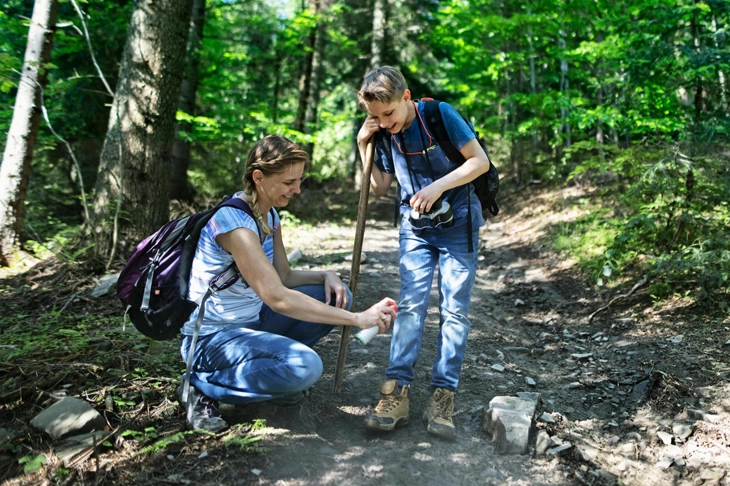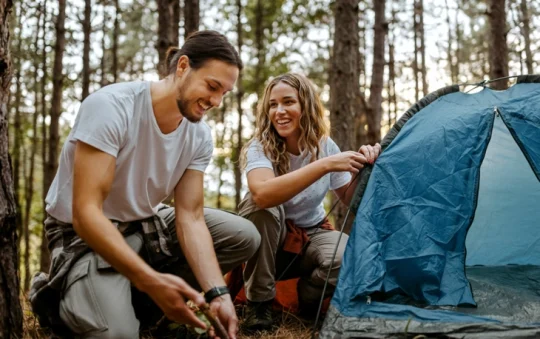Embarking on a backpacking adventure opens the door to a world brimming with natural wonders. Beyond the breathtaking views and winding trails, lies a set of fundamental skills that every backpacker needs.
This guide explores the essential basics that form the backbone of successful backpacking trips. These skills are your compass, your shelter, and your source of sustenance as you navigate through the wild. Whether you’re a seasoned hiker or just starting out, mastering these skills is crucial for both safety and making the most of your outdoor experience.
In this journey, we’ll dive into key navigation techniques, the art of setting up camp and shelters, strategies for managing supplies and staying hydrated, and the importance of safety and emergency preparedness. Embracing these core principles will help you approach your backpacking adventures with confidence and deepen your connection with nature.
Join us as we explore the essentials of backpacking and discover the wonders of the great outdoors together.
Navigation Skills
Effective navigation is the bedrock of successful backpacking, allowing you to confidently traverse diverse terrain and reach your goals. Whether you’re charting remote trails or exploring uncharted wilderness, mastering these skills is essential for both safety and peace of mind.
Reading Maps:
Understanding topographic maps is crucial for any backpacker. These maps provide valuable insights into the landscape, showing elevation changes, water sources, and landmarks. By learning how to interpret contour lines, symbols, and scale, you’ll be able to gauge distances and plan your route with precision.
Using a Compass:
While GPS technology is handy, a compass remains a vital tool for wilderness navigation, especially where satellite signals are weak. Get comfortable with basic compass skills such as taking bearings, aligning your map, and using the compass in conjunction with map features.
Leveraging GPS Technology:
GPS devices are incredibly useful for navigating tricky terrain. Familiarize yourself with your GPS’s features, like setting waypoints, tracking your route, and using breadcrumb trails to retrace your steps. However, always bring a paper map and compass as backups in case your device fails or the battery runs out.
Getting Oriented:
Before you hit the trail, take a moment to familiarize yourself with the area. Identify key landmarks, understand the orientation of rivers or mountain ranges, and mentally map out your route. Stay alert to trail signs, junctions, and natural markers to keep yourself on course.
Preparing Thoroughly:
Proper preparation is key to a successful trip. Research your route extensively, taking note of trail conditions, potential hazards, and water sources. Have contingency plans in place and let someone know your itinerary before you set out.
By honing your navigation skills and practicing regularly, you’ll gain the confidence to explore new trails and wilderness areas safely. Remember, navigation is not just about finding your way—it’s also about enjoying the journey and immersing yourself in the beauty of nature.
Setting Up Shelter and Campsites for Backpacking
Choosing the right campsite and setting up your shelter are essential skills for any backpacker. A well-selected campsite not only offers comfort and protection from the elements but also helps minimize your impact on the environment. Here’s a guide to help you make the best choices for your campsite and shelter:
Picking the Perfect Campsite:
Look for a flat, well-drained spot away from potential hazards like dead trees or rocky ground. Consider how close you are to water sources, the direction of prevailing winds, and how much sunlight the site gets. Stick to established campsites whenever possible to help preserve the natural environment.
Types of Shelters:
Backpackers have various shelter options, including tents, hammocks, tarps, and bivy sacks. Each type has its benefits and drawbacks depending on weight, weather conditions, and your personal preferences. Make sure to practice setting up your chosen shelter before you head out so you can pitch it quickly and easily on the trail.
Setting Up Your Shelter:
Proper setup is key for comfort and protection. Follow the instructions for your tent, ensuring it’s securely anchored and well-staked. For hammocks or tarps, pay attention to the angle and spacing between trees to ensure stability and comfort.
Organizing Your Campsite:
Keep your campsite tidy and efficient to reduce your impact. Designate specific areas for cooking, eating, resting, and storing your gear. Store food in bear-proof containers to avoid attracting wildlife, and always clean up all waste before you leave.
Following Leave No Trace Principles:
Respect the natural world by adhering to Leave No Trace principles. Properly dispose of waste, limit the impact of campfires, and be mindful of wildlife. Leave your campsite in better shape than you found it, so others can enjoy it just as much.
Mastering these skills will help ensure a safe and enjoyable backpacking experience. By prioritizing environmental care, you contribute to preserving these beautiful areas for future adventures.
Food and Water Management

Managing food and water effectively is key to staying energized, hydrated, and healthy on your backpacking adventure. Knowing how to source, treat, and conserve these vital resources will ensure you have a safe and enjoyable journey. Here’s how to tackle food and water management:
Staying Hydrated:
Keeping hydrated is essential, especially in hot or dry conditions. Carry enough water or identify reliable water sources along your route. Plan your water intake to stay hydrated throughout the day, taking into account your activity level, the weather, and humidity.
Water Purification:
Treating water from natural sources is crucial to avoid illness. Use portable filters, chemical tablets, or UV light devices to purify water in the wild. Always follow the instructions provided for safe and effective purification.
Planning Meals:
Plan your meals to ensure you get the right balance of nutrition and energy. Choose lightweight, non-perishable foods packed with calories and nutrients, like dehydrated meals, nuts, dried fruits, and energy bars. Consider the weight, size, and ease of preparation when selecting your food.
Storing Food:
Proper food storage is vital to prevent wildlife encounters and minimize your environmental impact. Use bear-resistant containers or hang food and scented items away from your campsite, particularly in bear-active areas. Keep food and waste separate from your sleeping area to avoid attracting wildlife.
Disposing of Waste:
Follow Leave No Trace principles by minimizing food waste and disposing of scraps and packaging properly. Pack out all trash, including wrappers and peels, to leave your campsite clean. Avoid burying or burning food waste, as this can attract wildlife and disrupt ecosystems.
By focusing on effective food and water management, you’ll keep your energy up and your impact low, leading to a rewarding and sustainable backpacking experience. Plan ahead, stay hydrated, and tread lightly to make the most of your outdoor adventures.
Safety and Emergency Preparedness
Staying safe and prepared for emergencies is essential for any backpacker, as it empowers you to tackle potential risks and unforeseen challenges with confidence. By equipping yourself with the right knowledge, skills, and gear, you can navigate the wilderness more safely. Here are some key principles for ensuring safety and readiness:
First Aid Essentials:
Always pack a well-equipped first aid kit tailored for the kinds of injuries and emergencies you might face on the trail. Include basics like bandages, antiseptic wipes, adhesive tape, pain relievers, and blister treatment supplies to handle minor health issues effectively.
Emergency Shelter:
Include a lightweight emergency shelter in your gear, such as a space blanket, bivy sack, or compact tent. This will offer crucial protection if you face severe weather or need to spend an unplanned night outdoors. Choose one that’s durable, weather-resistant, and easy to set up.
Communication Tools:
Bring along reliable communication devices like a cell phone, satellite phone, two-way radio, or personal locator beacon (PLB) for emergency situations. Make sure these devices are fully charged and can receive a signal in your hiking area.
Navigation Instruments:
Carry trustworthy navigation tools like a map, compass, or GPS device to help you find your way through unfamiliar terrain. Get comfortable with basic navigation skills such as reading maps, using a compass, and operating a GPS to confidently explore new landscapes.
Emergency Protocol:
Create a clear emergency protocol outlining steps to take for various scenarios, such as injuries, getting lost, or severe weather. Share your itinerary and emergency plan with a trusted person before you head out, and set up a schedule for regular check-ins.
Weather Awareness:
Keep track of weather conditions in your hiking area and be ready to adjust your plans based on changing forecasts. Stay updated with weather reports before and during your trip, and be prepared to seek shelter or alter your route to avoid dangerous conditions.
Leave No Trace:
Follow Leave No Trace principles to reduce your environmental impact and protect natural areas for future adventurers. Keep your campsite clean, pack out all trash, and avoid disturbing wildlife or sensitive habitats.
By staying informed, prepared, and proactive, you can ensure a safe and enjoyable adventure in the great outdoors.
In Conclusion
Mastering essential backpacking skills is key to having safe and rewarding adventures in nature’s stunning landscapes.
Strong navigation skills are crucial for confidently finding your way across diverse terrains and reaching your goals. Setting up shelters and campsites effectively ensures that you’re comfortable and protected from the elements. Managing food and water resources wisely keeps your energy up throughout the trip, while being prepared for emergencies helps you handle unexpected situations with ease.
Following Leave No Trace principles is vital to preserve the beauty of the wilderness. This means packing out all waste and leaving campsites as you found them. Embrace each journey with curiosity, humility, and a deep respect for the natural world, whether you’re embarking on a short hike or a long trek. Every step in the wild is an opportunity for growth, exploration, and a profound connection with nature.
As you head out, find rhythm in your journey, draw inspiration from your surroundings, and take pride in overcoming challenges. Equip yourself with reliable cooking gear for easy meal prep on the go. May your adventures be filled with lasting memories and a deep appreciation for the transformative power of the outdoors.
Safe travels, and may your adventures reflect the boundless horizon that lies ahead.





